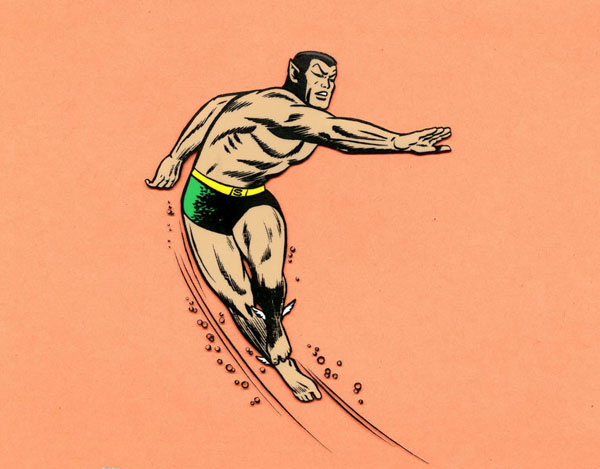
SUSPENDED ANIMATION #233
One of the most popular Marvel Comics’ characters to not yet make an appearance in the Marvel Cinematic Universe is Prince Namor the Sub-Mariner.
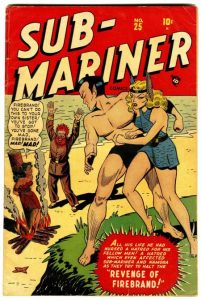 The creation of artist Bill Everett, Sub-Mariner first appeared in a limited edition theater giveaway comic book entitled Motion Picture Funnies Weekly in 1939 and the story was later reprinted that same year in Marvel Comics #1, making him the longest running Marvel character.
The creation of artist Bill Everett, Sub-Mariner first appeared in a limited edition theater giveaway comic book entitled Motion Picture Funnies Weekly in 1939 and the story was later reprinted that same year in Marvel Comics #1, making him the longest running Marvel character.
An American expedition to the Antarctic discovered a race of undersea people from Atlantis. The captain of the ship fell in love with the princess and she gave birth to their child who grows up to be Namor. Sub-Mariner debuted two years before DC’s Aquaman who didn’t appear until 1941 but had a similar concept.
Sub- Mariner had a healthy run in comic books during the Golden Age through the mid-1950s. He was revived in the Silver Age in 1962 when he was re-discovered by the Human Torch of the Fantastic Four and appeared in several different comics before getting his own series in Tales to Astonish #70 (August 1965). In that comic book, he was written by Stan Lee and drawn by Gene Colan.
So he was extremely popular when producer Robert Lawrence selected the character along with Hulk, Iron Man, Thor and Captain America for the 1967 Grantray-Lawrence animated The Marvel Superheroes television series. Actor John Vernon voiced Namor.
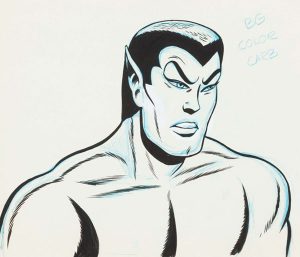 Most of the animation drawings were taken directly from the Marvel comic books themselves. Offset copies of the artwork were made, word balloons and captions were removed and the backgrounds changed or deleted. Sometimes parts of hands, heads or other items had to be extended or drawn by staff artists because they were missing in the original comic book panel. Approximately 48 layout artists were responsible for converting the comics to animation including Mike Royer.
Most of the animation drawings were taken directly from the Marvel comic books themselves. Offset copies of the artwork were made, word balloons and captions were removed and the backgrounds changed or deleted. Sometimes parts of hands, heads or other items had to be extended or drawn by staff artists because they were missing in the original comic book panel. Approximately 48 layout artists were responsible for converting the comics to animation including Mike Royer.
Then the picture or some individual element like Captain America’s shield or lips would be moved or the camera would zoom in and out or pan quickly in an attempt to create the illusion of movement. In addition, a Jack Kirby drawn version of the character might suddenly shift to one drawn by Don Heck or Steve Ditko.
“One of the secrets of Marvel’s success is its ability to draw action right into its panels,” claimed Lawrence. “The characters don’t actually move, and yet their actions seem to flow, catching the reader up in a current of activity. Since we wanted to retain this flow for our films, we decided to let the (Marvel) artists carry the ball and the viewer just as they do their own readers.”
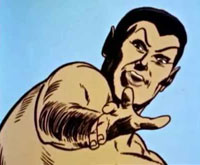 Each character had thirteen episodes that each included three separate cliff-hanging segments so that the episode could be shown as a single half-hour adventure or broken up into a serial format of a seven minute offering with the next installment shown later. The budget was between fifteen and twenty thousand dollar for each half hour.
Each character had thirteen episodes that each included three separate cliff-hanging segments so that the episode could be shown as a single half-hour adventure or broken up into a serial format of a seven minute offering with the next installment shown later. The budget was between fifteen and twenty thousand dollar for each half hour.
The Sub-Mariner adventures proved to be the most difficult for Grantray-Lawrence because there were only a limited number of new stories to adapt since Namor’s tales had not begun until mid-1965. In addition, Gene Colan’s distinctive artwork was a little too distinctive. Much of that artwork had to be significantly re-drawn to make it usable for the xerography technique.
Additional original adventures for Namor were created by having Doug Wildey, Sparky Moore and other staffers do sketches that could be used in a similar fashion to the Marvel comic panels. Artist Jerry Grandenetti did at least one original storyboard for the Sub-Mariner that was never used.
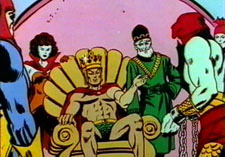 Some episodes featured stories that were due to be printed in early 1967 before those issues even hit the stands. In an attempt to find more material for the Sub-Mariner, the studio even tried to adapt some of the adventures that had appeared in the Fantastic Four comic books.
Some episodes featured stories that were due to be printed in early 1967 before those issues even hit the stands. In an attempt to find more material for the Sub-Mariner, the studio even tried to adapt some of the adventures that had appeared in the Fantastic Four comic books.
However, Hanna-Barbera had optioned the animation rights to the Fantastic Four so in the MSH episode Dr. Doom’s Day loosely adapting Fantastic Four #5, the FF were replaced by the original X-Men and the Baxter Building became the Peace Building.
Hanna-Barbera faced a similar situation. For their Fantastic Four episode entitled “Danger in the Depths” based on the story in Fantastic Four #33, they changed the flesh-colored Namor into the blue-skinned Prince Triton of Pacifica (voiced by Mike Road) with Alex Toth doing the character design. Strangely, Namor’s girlfriend Lady Dorma and his enemy Attuma were able to keep their names in both the H-B and Grantray-Lawrence versions.
 About Grantray-Lawrence, writer Stan Lee gushed at the time, “They’ve been an absolute joy to work with. They check with us on everything and they’re tremendously anxious to keep with the spirit of our strips and stories. The original stories have been changed to some degree because some of them aren’t complete in themselves. And the animation studio has to change the ending so it seems like it’s a complete episode.”
About Grantray-Lawrence, writer Stan Lee gushed at the time, “They’ve been an absolute joy to work with. They check with us on everything and they’re tremendously anxious to keep with the spirit of our strips and stories. The original stories have been changed to some degree because some of them aren’t complete in themselves. And the animation studio has to change the ending so it seems like it’s a complete episode.”
After the series ended, Lee told a New York comic book convention crowd, “They insist on strict simplicity. This immediately eliminates everything that is Marvel. We just gave up on them and they went off on their own to do all new stories. Personally, I was very dissatisfied with the way our heroes were handled.”
Grantray-Lawrence went bankrupt in 1967 and its distributor, Krantz Films, took over including continuing the first animated Spider-Man television series.

The Sub-Mariner’s theme song, as were all the other songs for the Grantray-Lawrence series, was written by New York songwriter Jack Urbont, whose resume includes soap-opera themes and scores (General Hospital, One Life to Live), successful off-Broadway musicals (All in Love), Emmy-winning nature series (Lorne Greene’s New Wilderness) and dramatic underscores for prime-time series (Mission: Impossible).
He had never read a Marvel comic book so Lee gave him some copies for the characters to be animated and he came back in a few days with the demos that Lee and the producers approved.
The Sub-Mariner theme song was: “Stronger than a whale, He can swim anywhere, He can breathe underwater, or go flying through the air! The noble Sub-Mariner is the prince of the sea, so be wary every demon, ‘cause Namor of Atlantis is the prince of the sea!”
Grantray-Lawrence Sub-Mariner Filmography
• Episode 1: Peril in the Surface World, So Spreads the Net, The Unveiling
• Episode 2: The Start of the Quest!, Escape to Nowhere, A Prince There Was
• Episode 3: Not All My Power Can Save Me!, When Fails the Quest, The End of the Quest
• Episode 4: Atlantis Under Attack, The Sands of Terror, The Iron Idol of Infamy
• Episode 5: The Thing from Space, No Escape for Namor, A Prince Dies Fighting
• Episode 6: To Conquer a Crown, A Prince No More, He Who Wears the Crown
• Episode 7: To Walk Amongst Men!, When Rises the Behemoth, To the Death
• Episode 8: The World Within!, Atlantis Is Doomed, Quest for X-Atom
• Episode 9: Beware the Siren Song, Spell of Lorelei, Return of the Mud Beast
• Episode 10: Ship of Doom, Fall of Atlantis, Forces of Vengeance
• Episode 11: The Planet of Doom, To Test a Prince, To Save a Planet
• Episode 12: Dr. Doom’s Day, The Doomed Allegiance, Tug of Death
• Episode 13: Let the Stranger Die..!, To Destroy a Tyrant, Save A City
The Sub-Mariner later appeared in animated form in Spider-Man (1981) “Wrath of the Sub-Mariner”; Spider-Man and His Amazing Friends (1981) “7 Little Superheroes”; Fantastic Four: The Animated Series (1994) “Now Comes the Sub-Mariner”; and Fantastic Four: World’s Greatest Heroes (2006) “Imperious Rex” and “Atlantis Attacks”


 Jim Korkis is an internationally respected animation historian who in recent years has devoted his attention to the many worlds of Disney. He was a columnist for a variety of animation magazines. With his former writing partner, John Cawley, he authored several animation related books including The Encyclopedia of Cartoon Superstars, How to Create Animation, Cartoon Confidential and Get Animated’s Animation Art Buyer’s Guide. He taught animation classes at the Disney Institute in Florida as well as instructing classes on acting and animation history for Disney Feature Animation: Florida.
Jim Korkis is an internationally respected animation historian who in recent years has devoted his attention to the many worlds of Disney. He was a columnist for a variety of animation magazines. With his former writing partner, John Cawley, he authored several animation related books including The Encyclopedia of Cartoon Superstars, How to Create Animation, Cartoon Confidential and Get Animated’s Animation Art Buyer’s Guide. He taught animation classes at the Disney Institute in Florida as well as instructing classes on acting and animation history for Disney Feature Animation: Florida.




















































Actually that Dr. Doom episode does not adapt FF#5, which was Doom’s first appearance. It adapts Fantastic Four Annual #1 where Reed Richards and Sue Storm had their wedding, which was attended by all the then-current Marvel heroes (including the X-Men) and Doom used his emotion charger to force a horde of villains to attack the affair.
Well, Reed and Sue’s wedding was actually in FF Annual # 3, but you’re correct that it wasn’t adapted from FF # 5. The epsode does, however, incorporate elements of FF # 6, which was reprinted in FF Annual # 3.
Funniest part was when it came out on VHS many years later, with Wolverine prominent on the box–a hot character who hadn’t even been conceived of in the 1960s! LOL
I think the theme song says “prince of the deep,” not “prince of the sea.”
This was a very interesting article. As a long time Marvel comics reader (started in 1963) I was glad to see Jack Kirby’s artwork animated, even with the severe limitations that were imposed. As I recall the Sub Mariner episodes were the ones that were broadcast least often, so I was surprised to see that there are 13 episodes in the list. I know and remember Vernon Holland as Iron Man/Tony Stark, but I didn’t realize that he also did Namor. I am going to have to watch these again to look for the change in artist mid episode. It will probably be fun to look for the changes, some of which I am sure will be obvious.
‘Vernon Holland’ didn’t voice either character, he was a football player in the NFL. John Vernon however, did the voices as well as play Dean Wormer in Animal House and Fletcher in The Outlaw Josie Wales among other roles.
I’ve always hated Sub-Mariner because of his name – Namor. C’mon, Roman spelled backwards? Brilliant! #sarcasm
That bothered me, too — and also the mighty robot, Tobor the 8th Man!
Marvel may have a better track record than DC when it comes to live-action films, but as far as animation is concerned it isn’t even a close contest. DC gave us the Fleischer Superman cartoons, established Filmation as a leader in Saturday morning TV programming, took Warner Bros. animation in an exciting new direction with its Batman and Superman series of the nineties, and continues its legacy today with shows like Justice League Unlimited. Marvel, on the other hand, gave us this abomination from Grantray-Lawrence — one of the worst cartoons of the sixties, which is saying a lot.
That said, I considered the Sub-Mariner the best of a bad lot for three reasons: (1) he looked like Mr. Spock; (2) his suitably dramatic theme music (the Hulk’s bouncy jingle, in particular, is jarringly inappropriate for the character and the genre); and most of all, (3) the shot of him swimming between the tentacles of the giant octopus. That single image, enhanced by the descending chromatic scale in the low brass, really blew my mind as a kid.
So I was very interested to read the background of the character. I had no idea the Sub-Mariner had such a long and venerable history. One might hope that the clowns at Marvel would treat him with greater respect.
But sadly, nothing said clowns do these days really surprises me. Personally I have no use for Marvel’s cinematic blockbusters. I find them slow-moving, overlong and, surprisingly given their comic book origins, drab and colorless. I’ll admit the acting is good, but as for superheroes, I’ll take Ray Dennis Steckler’s “Rat Pfink a Boo Boo” over anything in the Avengers series — and I’d rather watch an episode of Young Justice than either of them.
I faintly remember another HB “Fantastic Four” that seemed to be based on a Sub-Mariner story. Instead of Namor it had a scientist accidentally turning himself into a fin-headed mutant with power to sic whales on New York.
I also remember when the original Spider-Man series suddenly began looking very cheap — lots more stock animation of web-swinging, not always matched to the backgrounds — but paradoxically more ambitious in its layouts and stories (the Ralph Bakshi influence?). The same outfit produced “Rocket Robin Hood”, and both shows shared the same plot, villain and animation for at least one late episode.
The Submariner was a last-minute replacement for Spider-Man, when the web-spinner was licensed for his own network series on ABC.
BTW, Wallace Wood was slated to draw Subby’s series in TTA. His work on DAREDEVIL No. 7 as a successful tryout but he left Marvel in disgust before he could start. He was upset that the profit-sharing that Smilin’ Stan promised but never delivered.
For me, Sub-Mariner was the weakest one. I wished they did a Dare Devil series instead. Oh well.
There were plans for a Dare Devil animated series in the late 80’s/early 90’s. Mark Eviner was going to write for it and Murdock would have a seeing-eye dog that would help him fight crime.
For myself, the cartoons were how I became familiar with back issues of the comics I was missing. The lineup, as broadcast on weekday afternoons on WOR-TV in NYC:
Monday – Cap
Tuesday – Green Skin
Wednesday – Shell Head
Thursday – Goldilocks
Friday – Subby
I’m pretty sure the Submariner wasn’t from Atlantis, least not when Bill Everett had control of him. Don’t think he was a prince either.
Lady Dorma was a very beautiful sexy woman,but she was a bit independent for the age, remember women’s rights came to fruition around 1969-70,she held her own,too bad she died on her wedding day. I loved Lady Dorma for her wit,her charm,but especially her sexy body with a nice view of her breasts.
I loved this cartoon in the late seventies before school.It had a nataselgic feel to it plus the characters looked strong and cool to me.It also had many villains that are relevant today.
I was so angry that Marvel killed off the Lady Dorma in # 37(1971)! You couldn’t even let Dorma go down the isle to marry Namor, what reason was there to have Lady Dorma die? So what if she betrayed Namor a lot, she also told Krang to stuff it! I really took a liking to the Lady Dorma,and you broke a six year old kid’s heart when she died! Later, I added a few pictures of Dorma, showing her sexier side, showing her sexy breasts puff out in the plastic cage Krang imprisons her in TTA #72!
I think these might be the actual correct lyrics…
Stronger than a whale
He can swim anywhere
He can breathe underwater
And go flying through the air!
The noble Sub-Mariner
Prince of the deep
So beware you deadly demons…
Lord Namor of Atlantis
Is the prince of the deep!
Eversince my first Namor comic book, I’ve appreciated what the Sub-Mariner brought to the table. But even though they looked cute, I could never believe the little wings on his ankles could be nothing more than a nuisance and a painful vulnerability. The possibility that tiny wet feathered wings on the feet could zoom a big heavy strong guy or woman around in the air doesn’t fly.